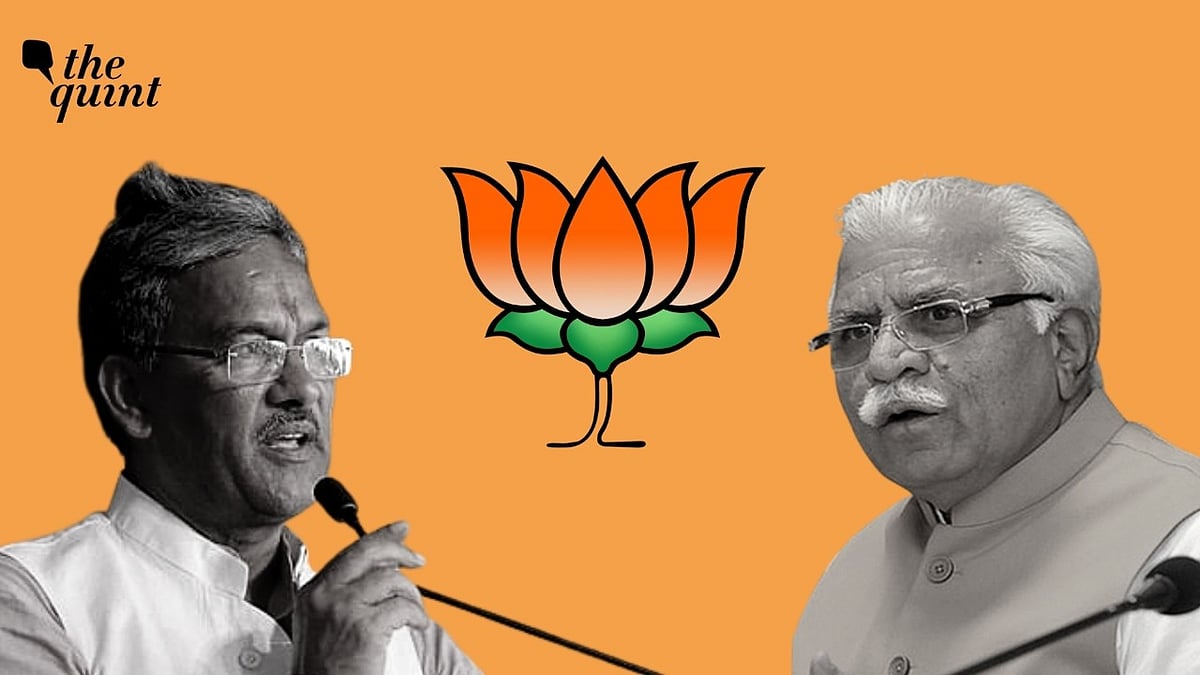
Haryana & Uttarakhand: The Common Factor Behind BJP’s Troubles
BJP may have survived but it remains to be seen how long it can manage internal contradictions in the two states.

advertisement
The BJP has managed to survive the crises in Haryana and Uttarakhand for the time being, with the Manohar Lal Khattar-led government defeating the no confidence motion in the former and Tirath Singh Rawat replacing Trivendra Singh Rawat as the chief minister in the latter.
Though the two states are different in their political realities as well as the nature of the crisis the BJP is facing, there is a common thread running through them.
What's Common Between Haryana and Uttarakhand
Both states represent the BJP's inability to paper over internal contradictions with its broader narrative of nationalism and Prime Minister Narendra Modi's popularity.
Remember, BJP swept both Haryana and Uttarakhand in the 2019 Lok Sabha elections and a vote share of close to 60 percent (58 percent in Haryana and 61 percent in Uttarakhand).
With both Uttarakhand and Haryana having a high population of ex-servicemen, the post-Pulwama attack narrative of national security found greatest resonance in these two states, contributing to the BJP sweep. A low population of non-Hindu communities also meant that the anti-BJP vote was lower than in states like say Punjab or Uttar Pradesh.
But the fact that less than two years since that complete sweep the BJP was faced with such a crisis, indicates that its national success didn't necessarily mean support at the state and local level as well.
Haryana
In Haryana, the troubles for BJP and CM Manohar Lal Khattar began with the 2019 Assembly elections, that took place soon after the Lok Sabha elections.
The BJP fell short of a majority in the state, mainly due to a significant shift of Jat votes away from the BJP to the Congress and Jannayak Janata Party. Though the BJP managed to form a government with the help of the JJP and Independents, its troubles didn't end.
The passage of three farm laws by the Narendra Modi government in 2020 sparked widespread protests in Punjab and Haryana, where farmers are most dependent on Minimum Support Prices.
This snowballed into a full-fledged social boycott of BJP, JJP and government-aligned Independents by farmers.
The BJP and JJP also faced reverses in the local body elections in Haryana, including in BJP's pocket-boroughs on the Grand Trunk Road such as Sonepat and Panipat.
The effect of the protests on JJP is far worse than for the BJP as its base almost entirely comprises Jat farmers, who are at the core of the protests.
The situation is so bad that JJP chief and Haryana Deputy CM Dushyant Chautala couldn't even make his helicopter land in his own village due to protests by farmers.
Now, the perception among many JJP supporters is that by supporting the BJP government in the No Confidence Motion, the JJP has chosen the fruits of power over the interests of farmers.
This is likely to lead to a shift in Jat votes to the Indian National Lok Dal and the Congress, though both BJP and JJP hope that PM Modi is able to pull a rabbit out of his hat by the time the next elections are held in 2024.
Uttarakhand
In Uttarakhand, however, time is not with the BJP, with Assembly elections due in early 2022.
In many ways Trivendra Singh Rawat's end was imminent. In one opinion poll after another, he was rated as among the most unpopular CMs in the country and by most accounts may have been voted out in 2022.
Rawat worsened his own case by two efforts at great centralisation of power:
First, the declaration of Gairsain as a commisionerate that sparked protests in Kumaon, a region where the BJP has been relatively week
Second, his attempt to exert greater government control over temple boards, which are extremely important in a state like Uttarakhand where temples are intergral to the ethos as well as the economy.
Both moves sparked outrage from within the BJP camp - Kumaon region MLAs in the first case and Hindutva outfits in the second.
The internal opposition sealed Rawat's fate. But it won't be easy ride for his successor Tirath Singh Rawat. Uttarkhand has a history of political instability and this has partly been due to inability of CMs to manage the interests of both regions. Teerath Singh Rawat is comparatively a political lightweight and much of his legitimacy would depend on the blessings of the BJP's central leadership. In fact, the new CM may be entirely dependent on PM Modi to secure re-election in next year's polls.
(At The Quint, we question everything. Play an active role in shaping our journalism by becoming a member today.)
- Access to all paywalled content on site
- Ad-free experience across The Quint
- Early previews of our Special Projects
Published: 10 Mar 2021,08:14 PM IST